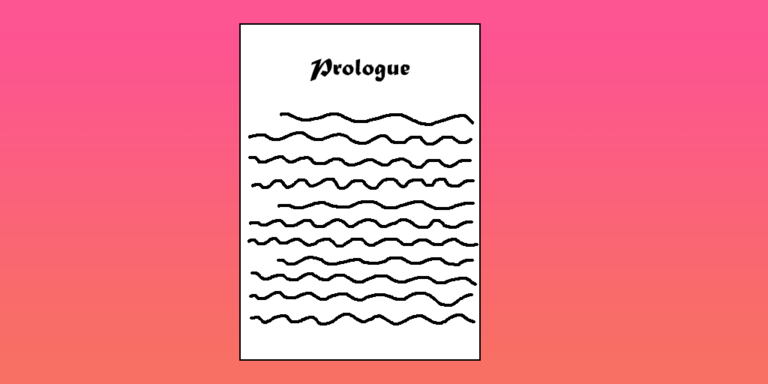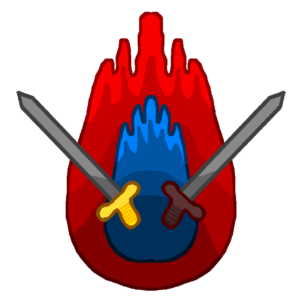Join US
Do you want to build the fantasy world you’ve always dreamed of?
Subscribe to receive notifications when a new post is out and for our monthly newsletter!
You can always unsubscribe anytime.


A fantasy book is split into several parts: the table of contents, the prologue, the chapters, and the epilogue. Sometimes it doesn’t have a prologue nor an epilogue. Each part plays an important role but the book prologue might be considered the most important one, for it does its fair deal of heavy lifting.
A book prologue may be used in different ways, depending on whether you’re writing a standalone novel or a series. If doing the former, it provides all the important info someone reading it for the first time ought to know before the first chapter. As for the latter, the prologue can serve as a brief summary of the events of the previous book so that readers remember what’s going on before they dive into the new novel.
The prologue is a part of the novel that takes place in-between the table of contents and the first chapter. It essentially telegraphs to readers everything they need to be aware of before they begin the novel proper. It can be used in a multitude of ways like covering the broad history of the world, important events that shaped the course of history, and so on.
How long should a prologue be? Very rarely is it just one page or less. It can span multiple pages, going as far up to maybe twenty or thirty though you’ll be pushing it. If you want to include one in your novel, you have to make the content fit the length.
While the book prologue can be immensely helpful in giving context, using it the wrong way can hurt your novel. Think of the prologue like your first chance to give a positive impression. Having the wrong impression means would-be readers are less likely to continue reading your story which means all your hard work will be for nothing!
This is article number thirty-seven in the series chronicling writing a fantasy book. If you’d like to take a gander at our many other articles, you can find them on our blog page.
The book prologue serves a vital role in the novel. It establishes the framework in which the story you’ve written takes place in. From a different perspective, the prologue gives the backstory so that first-time readers have a basic understanding of what’s going on as they begin to delve into your novel.
You can structure the prologue in many different ways. You can opt for a condensed history of the world your book is set in, hitting the highlights. Going another way, you can focus on events from the past like war that will affect the plot. Alternatively, you can do a list of major characters that your audience will meet throughout the story.
The bottom line is that you want to tie it in with what you wrote. Remember, this is your readers’ first time in your world. That means you need to give them just enough information to keep their interest while not overloading them with way too much which will turn them off.

Should you have one? Not every book in the genre has one. Some like “Lord of the Rings” does whereas others like “Harry Potter” don’t. If you feel like you should have one, go ahead and make one. If not, it’s fine. Only you can answer that yourself.
One thing to keep in mind about the book prologue is that how you use it depends a great deal on whether the novel you’re writing is a one-and-alone or part of a series. If you’re just doing one book, you can include it by telling your audience what they need to know or you can omit it entirely.
If you’re doing a series, the prologue works best as a recap of what happened in the previous book. It could feature major events like highlighting key settings like cities or castles or what significant characters did. Doing so enables your readers to quickly recall what took place so they can go in without missing a beat. If you’d prefer not to use a prologue in writing a series, that’s perfectly fine!
Now that you know what goes into a book prologue, you might be wondering how long should a prologue be? Well, the answer to that depends on what you’re going for and what you include in the prologue. There are several different situations that dictate how long it’ll be.
If you’re going for a standalone book, it shouldn’t take many pages. Maybe somewhere between ten and twenty, depending on how much info you want to tell your readers. You can get by with fewer than ten as long as you can make it work.
For those in a series, it gets a bit tricky. If you use the prologue as a way to recap what happened, you don’t want to take too long going over the events of the previous book since your readers will be eager to start reading. The more info you include in the recap, the longer the prologue will be. Ideally, the prologue should be approximately between five and ten pages but some go further than ten.

What you want to do here is make the content fit the length. It’s perhaps the best answer to how long should a prologue be. That means you jot down whatever information you want your readers to know prior to them reaching the first chapter. The more you add, the more pages the prologue will be.
Having the content fit the length enables you to not worry too much about how long a prologue should be as long as it’s actually germane to the plot. Your audience will appreciate it if the prologue is chock full of things that help them understand what they’re in for and won’t care one whit if it’s five or ten pages, as long as that info is helpful.
The prologue does a lot of work in preparing would-be readers for the story. It has to be simple to understand and make them more interested in the tale you’ve created from scratch. Unfortunately, it’s easy to go awry when constructing the prologue and this section will highlight what you need to avoid when writing it.
The first thing to not do is to overload it with too much info. Think it about it from the reader’s perspective. If the prologue has a ton of info, he has a lot to process in a short period of time and that’s before he starts the first chapter! The remedy for this is to thin it out, meaning you have to take some things out.
Secondly, don’t provide info that doesn’t become relevant until late in the story. The prologue’s purpose is to get readers ready for the first chapter. Everything in it needs to be relevant to the beginning of the story, not later on. Putting info in it that doesn’t play a role until later on means your readers will forget about it.

The third thing to avoid is over-complicating it. The prologue needs to be simple, straightforward, and presented in an easy-to-understand format. Putting information that’s hard to understand in it or using advanced vocabulary makes it more difficult for your readers to grasp what you’re saying. Rather, break it down in bite-sized pieces and use vocabulary everyone can understand.
Fourthly, don’t unnecessarily pad it. If you decide to have a set number of pages but what you’ve written falls short of that target, don’t put more info in to try to reach that number. You’ll only confuse your audience and they’ll see right through it. Just keep what you originally wrote and have the prologue be shorter than you expected it. Having it be shorter means they’ll reach the first chapter faster!
The fifth and last thing to not do is treat it like a chapter in your book. While it’s considered part of the story, it really is separate from it. The prologue is meant to set the main plot lines of your tale up. Don’t have it serve as the actual beginning of your story and doing this will bamboozle your readers.
The book prologue is an integral part of a novel. It has but one single goal: to provide readers with the info they need to know before they begin reading the book proper. You want to write one that encourages them to keep reading, not bore or confuse them.
A prologue can be used in several different ways, all of which depend on the situation. If you’re penning just one book, it’s best served with the vital info readers need to know. If you’re writing a series, the prologue is customarily used as a short summary of what happened in the previous book.
How long should a prologue be? Like in the previous paragraph, its length varies from one situation to another. In some cases, it can be five to ten pages whereas in others, it can be between ten and twenty. One rule of thumb to use regardless of the situation is to have the content fit the length, not the other way around.
The prologue is supposed to gin up interest in your story and there are things you shouldn’t do that will only depress your readers’ interest. One such is to bombard your audience with too much information. Another is to make it too complicated to understand and follow.
Will you create a stellar book prologue that spurs your audience to leap right into the story you’ve created from the ground up?
Let me know what you think in the comments below. (Note: this is an account-exclusive feature).
If you don’t have one, you can register here. It only takes a few moments of your time!
Liked this article and want to subscribe? All you have to do is fill out the form below and that’s it!
Thanks for reading this and until the next time,
Sunfire
Subscribing means you receive:
You can always unsubscribe anytime.
Do you want to build the fantasy world you’ve always dreamed of?
Subscribe to receive notifications when a new post is out and for our monthly newsletter!
You can always unsubscribe anytime.